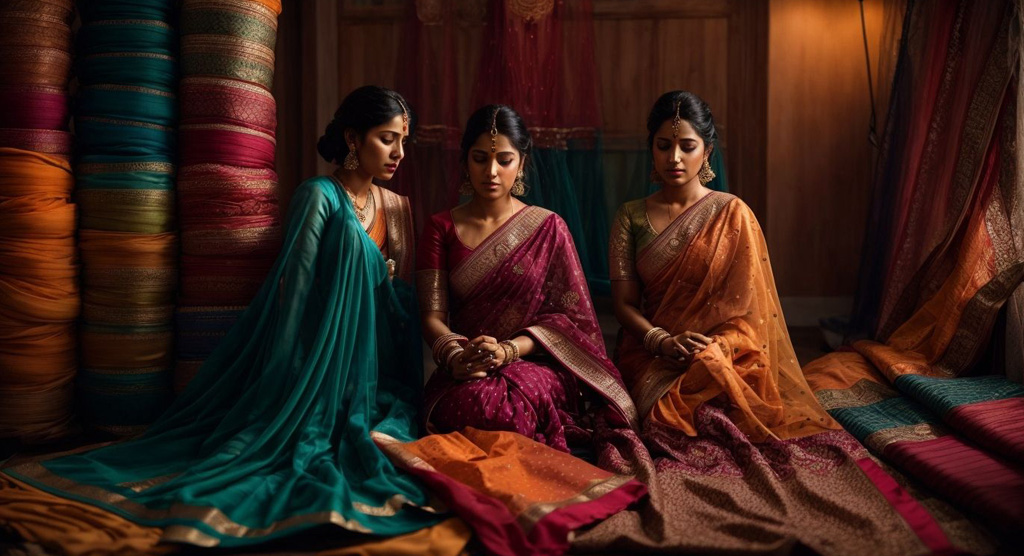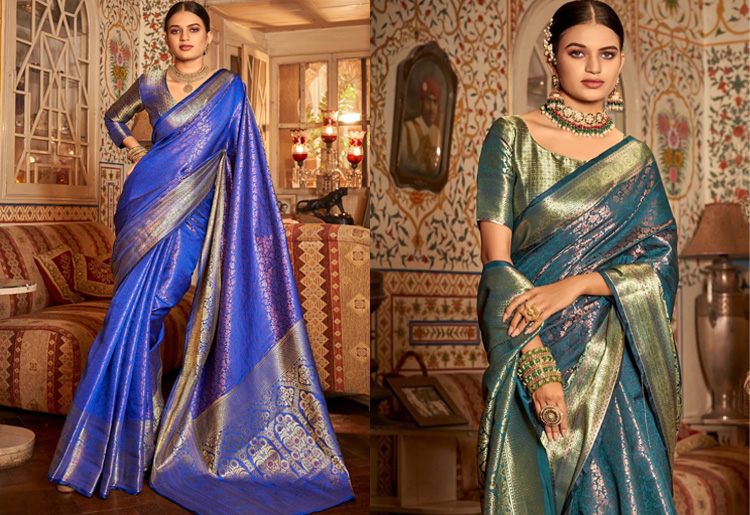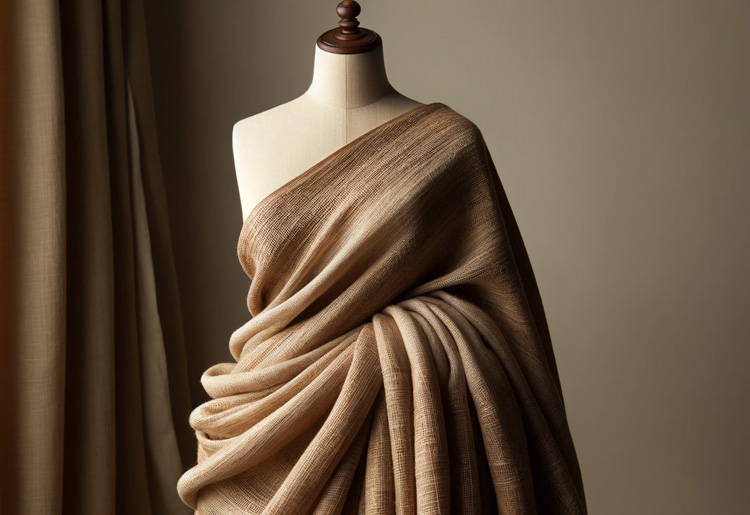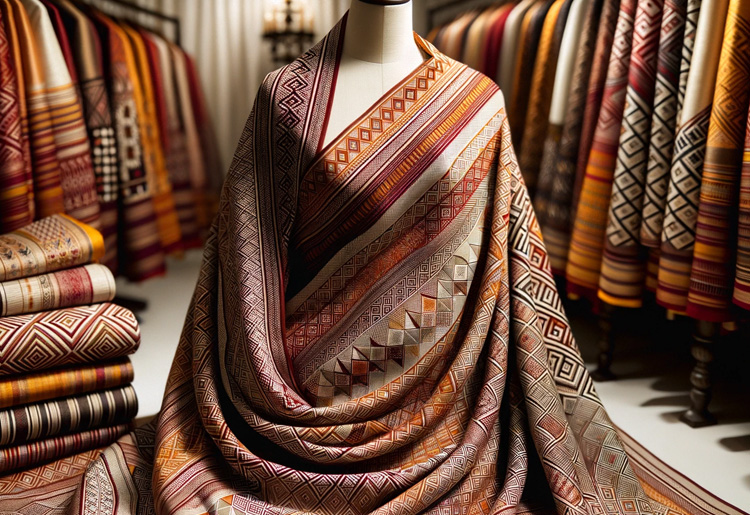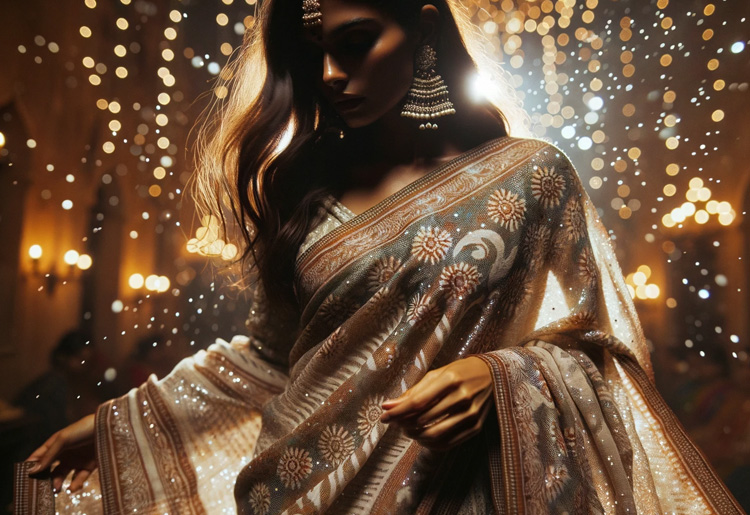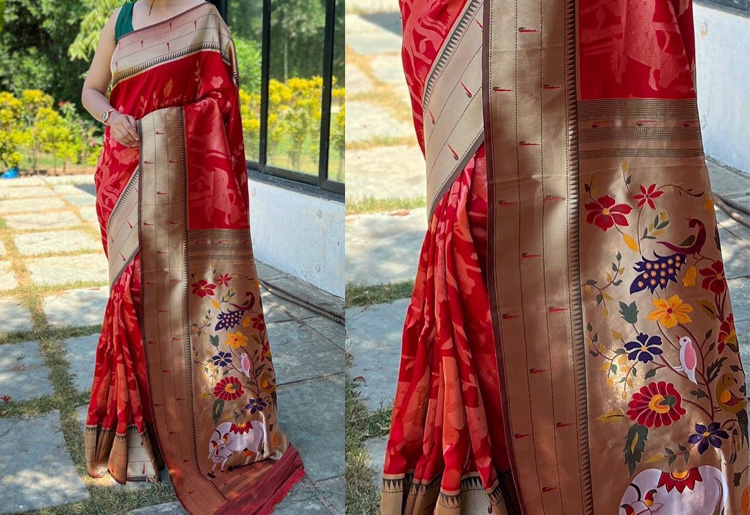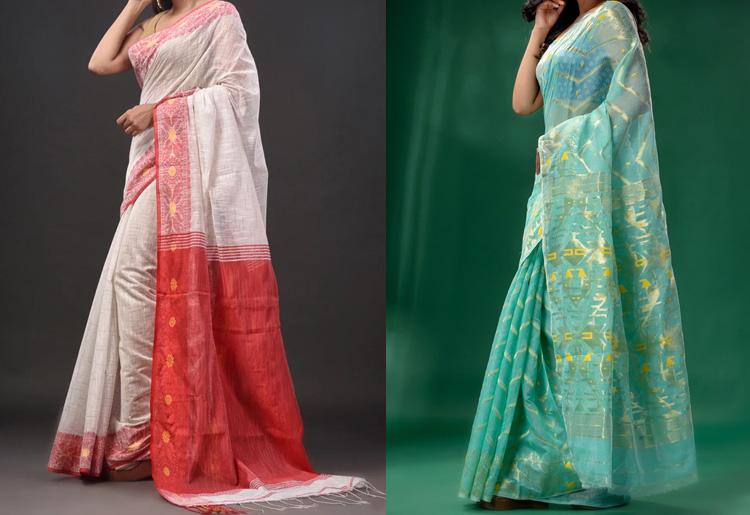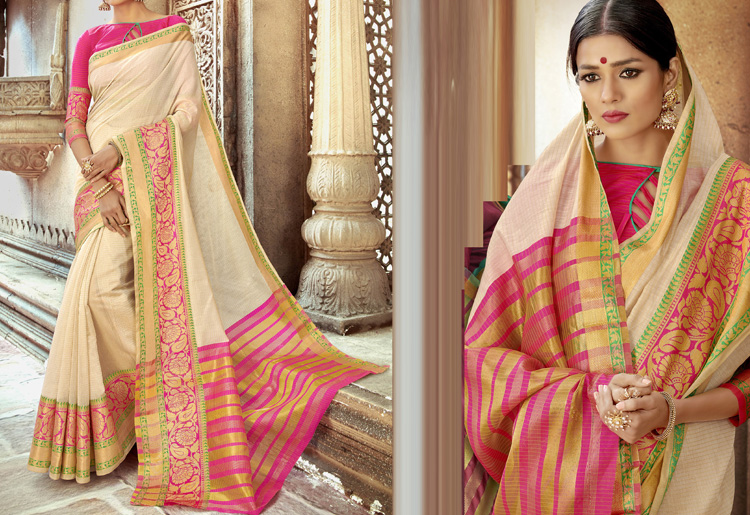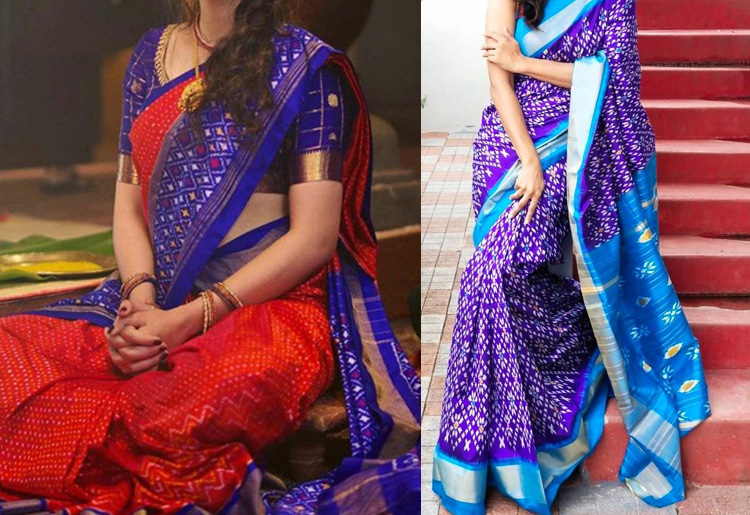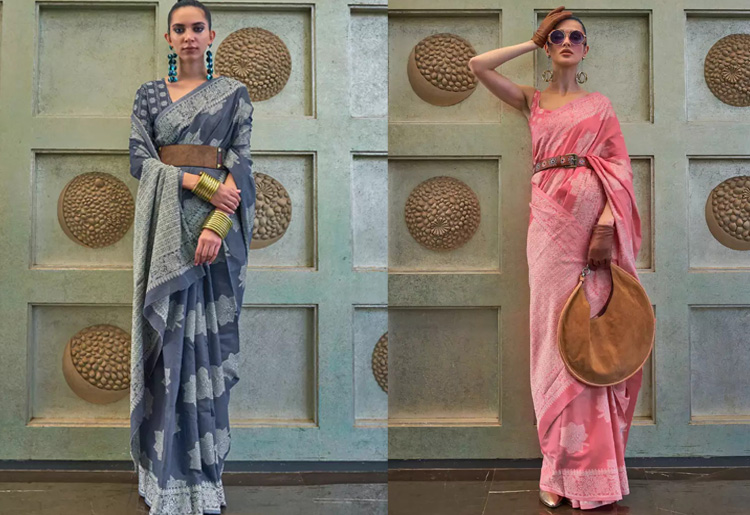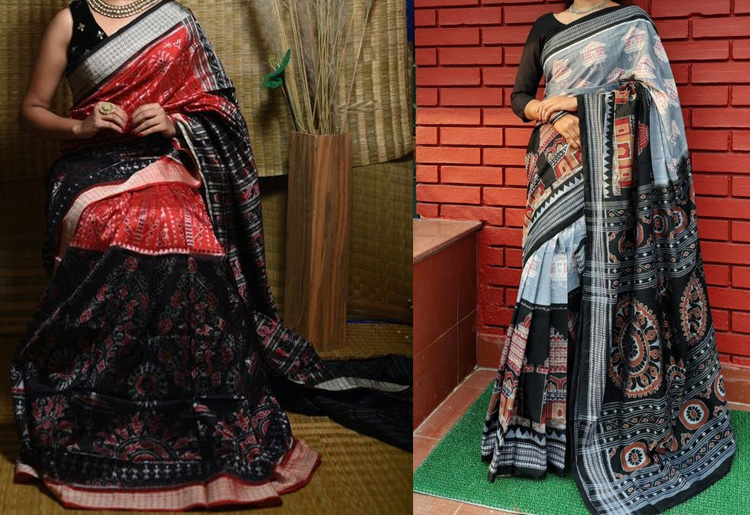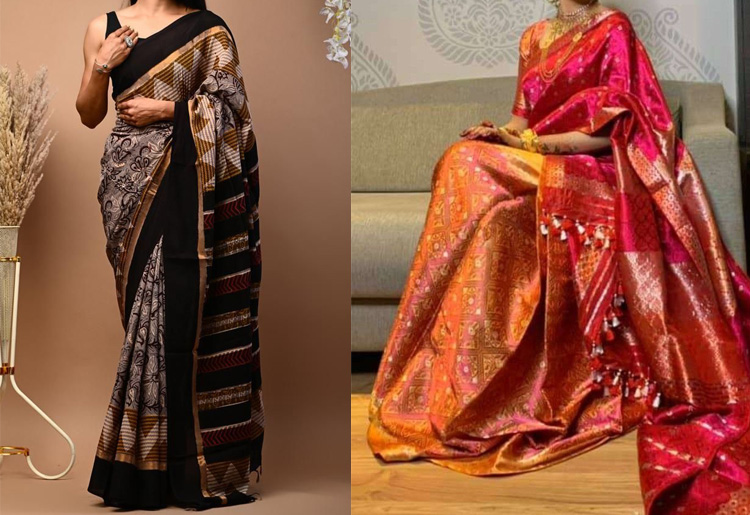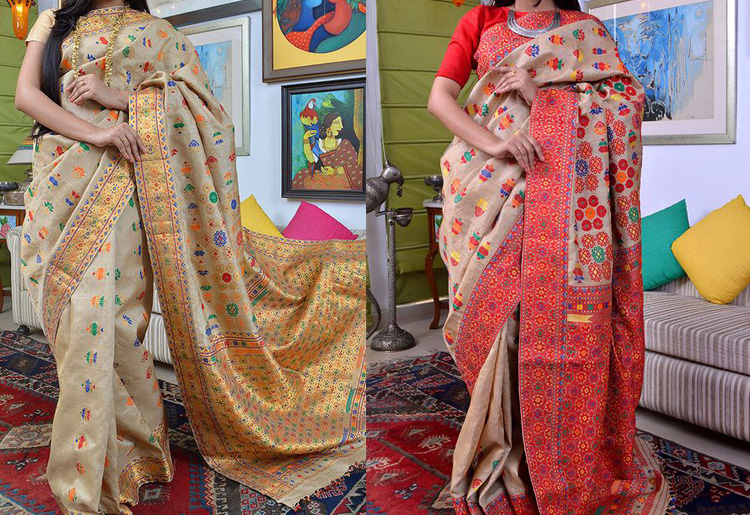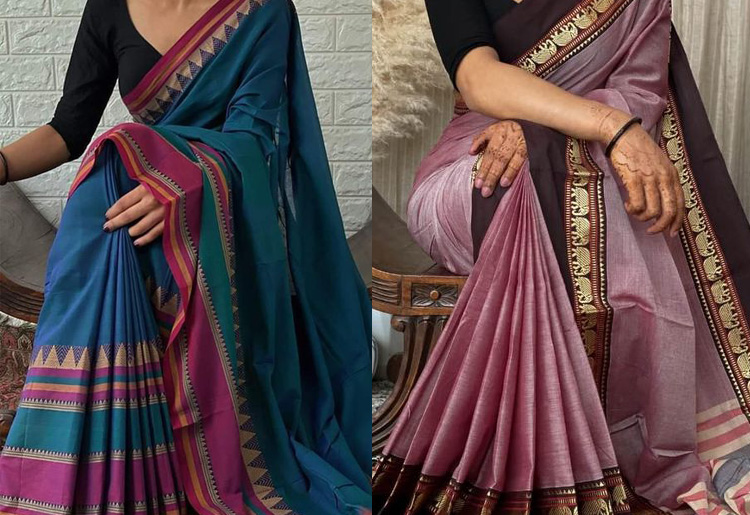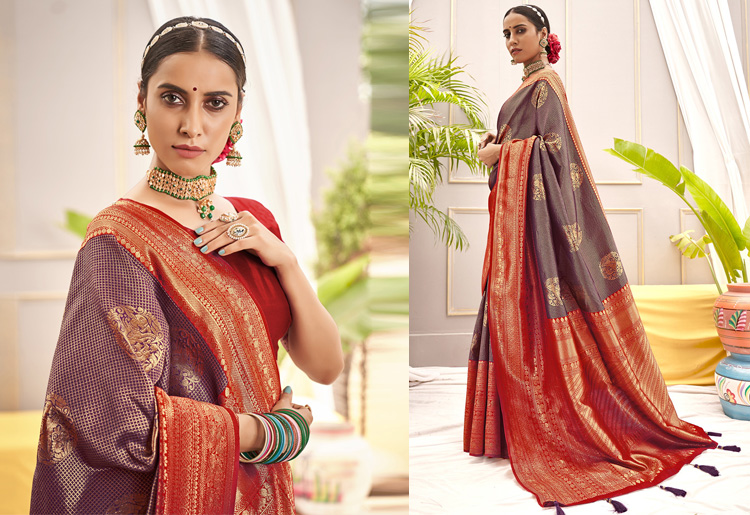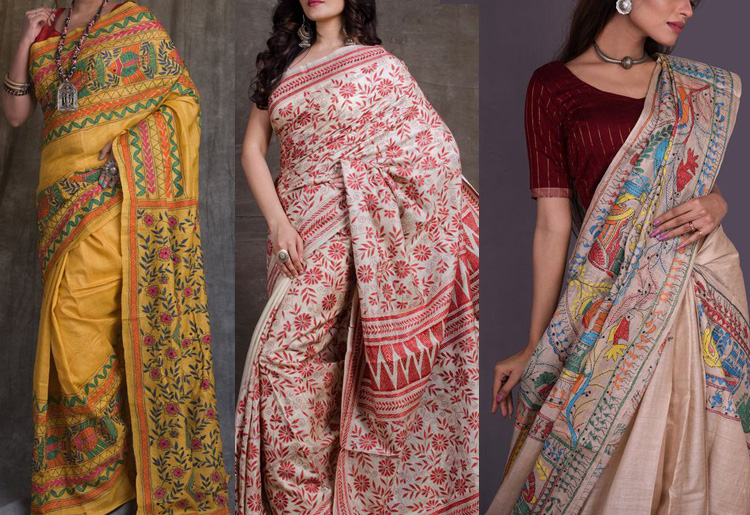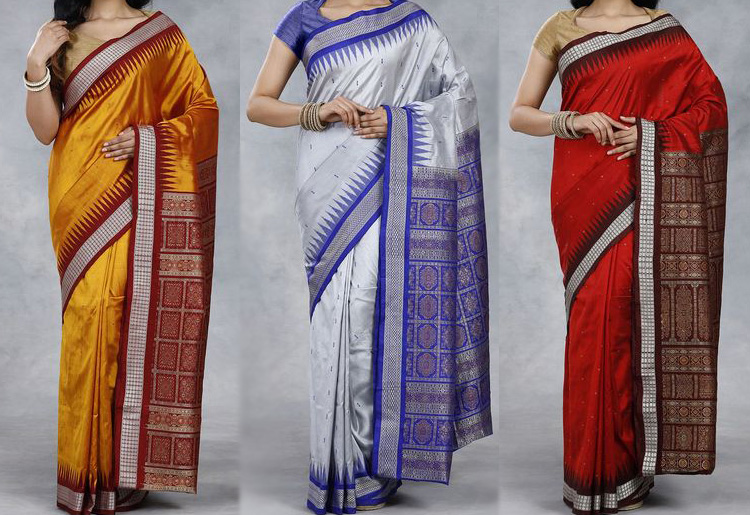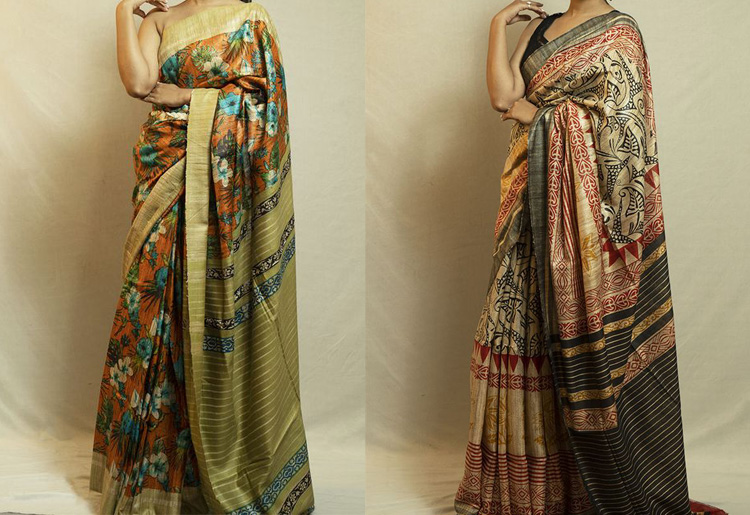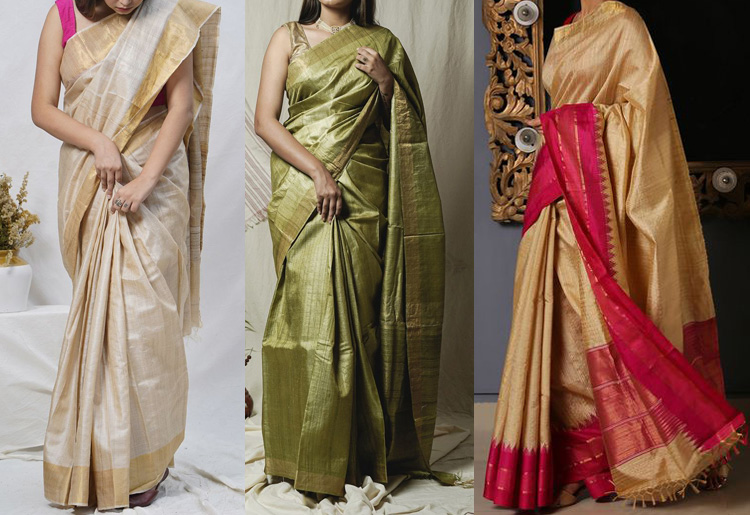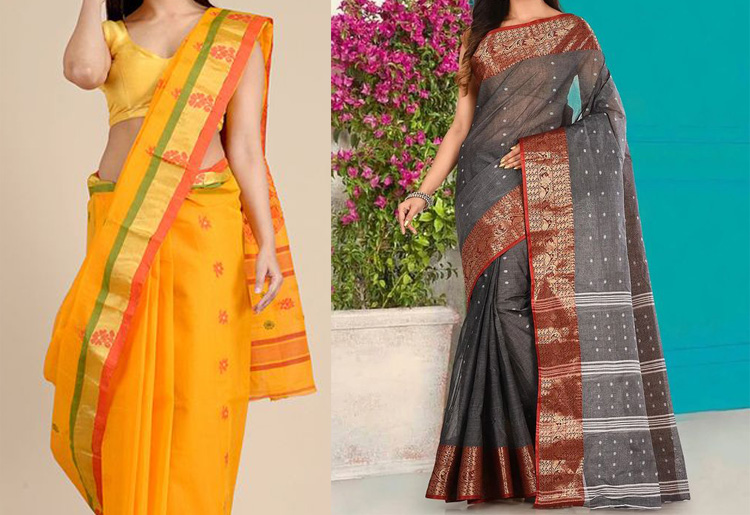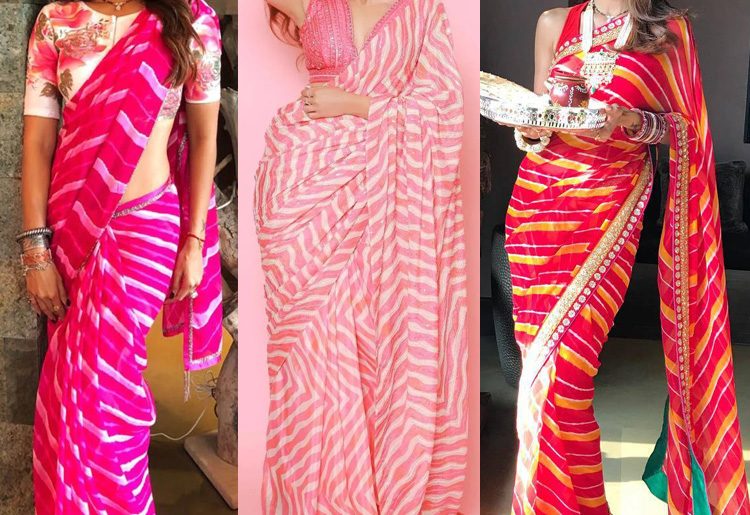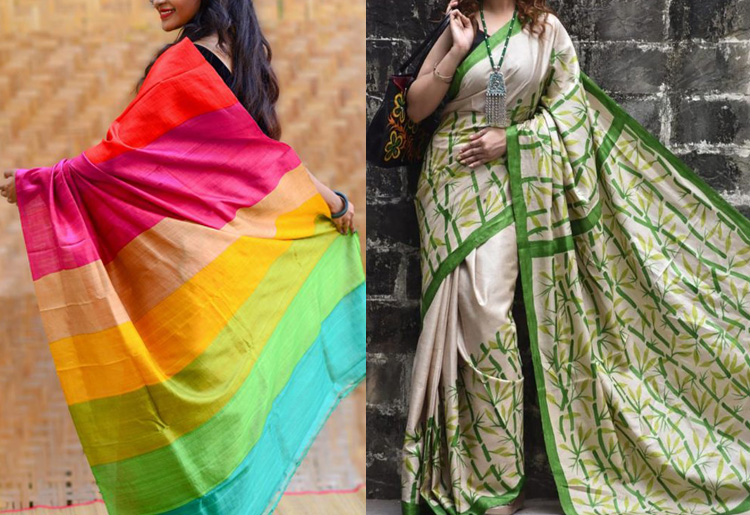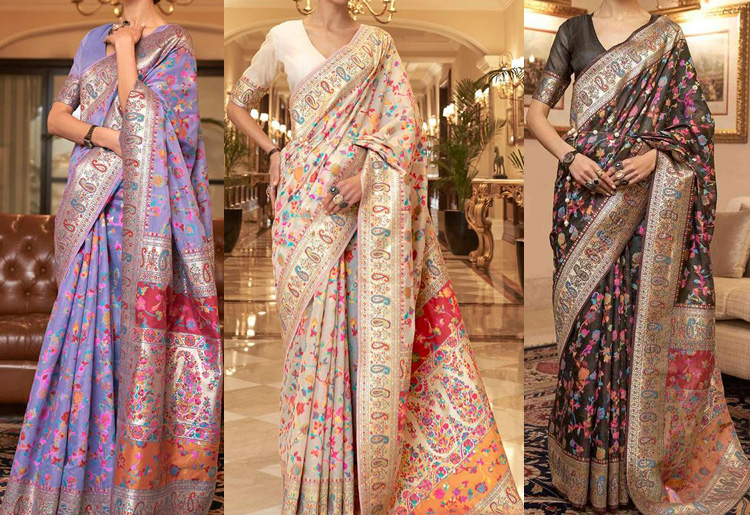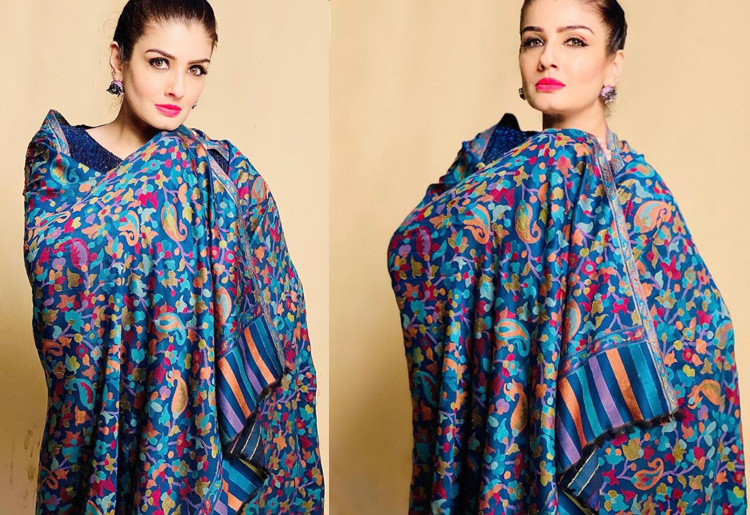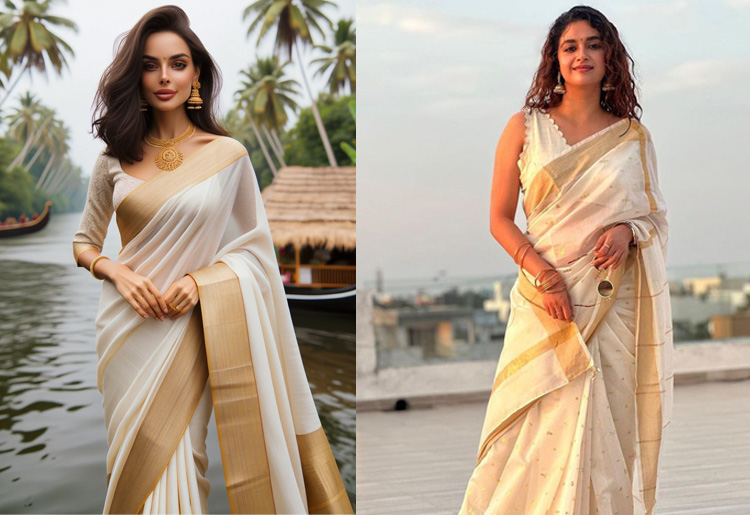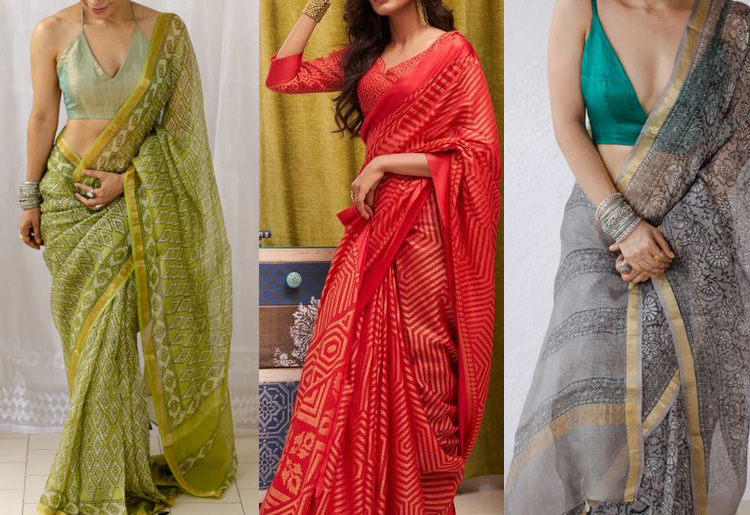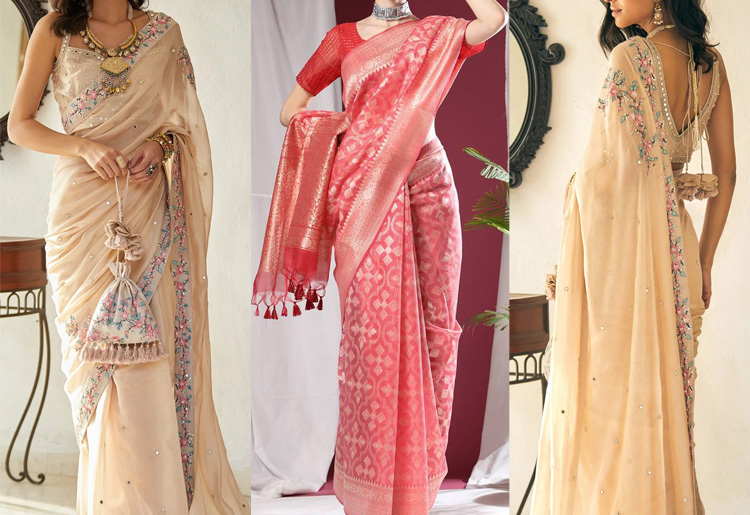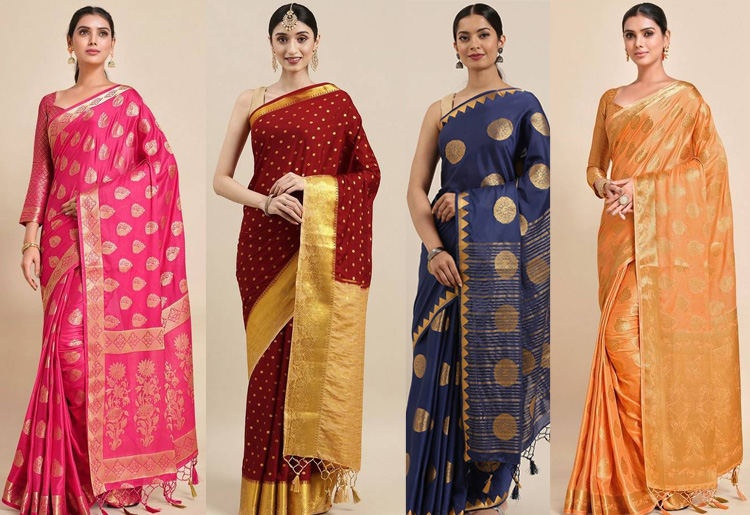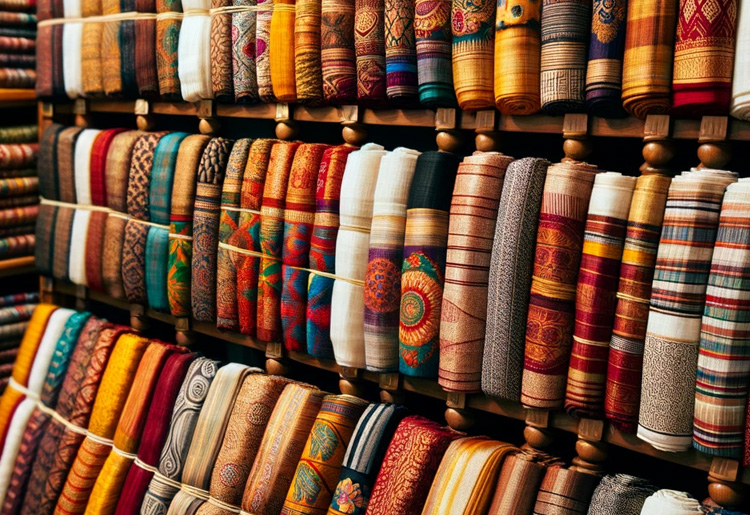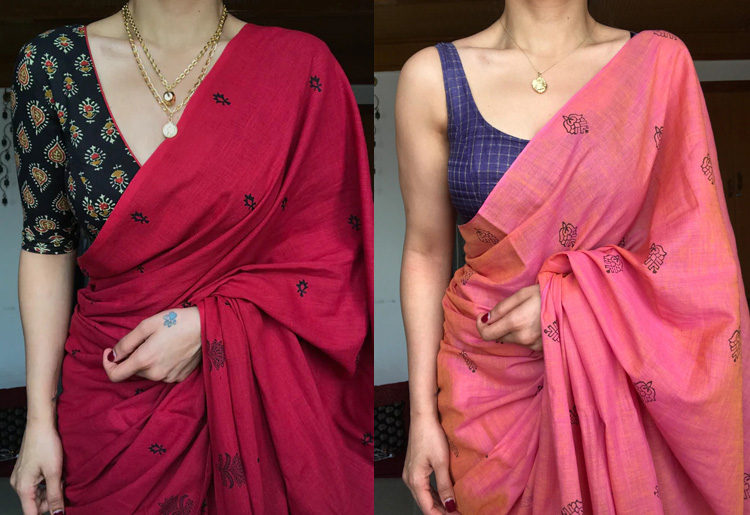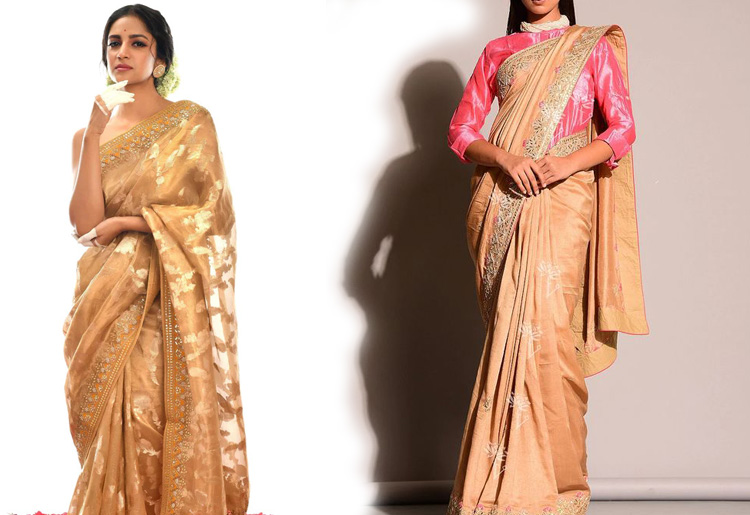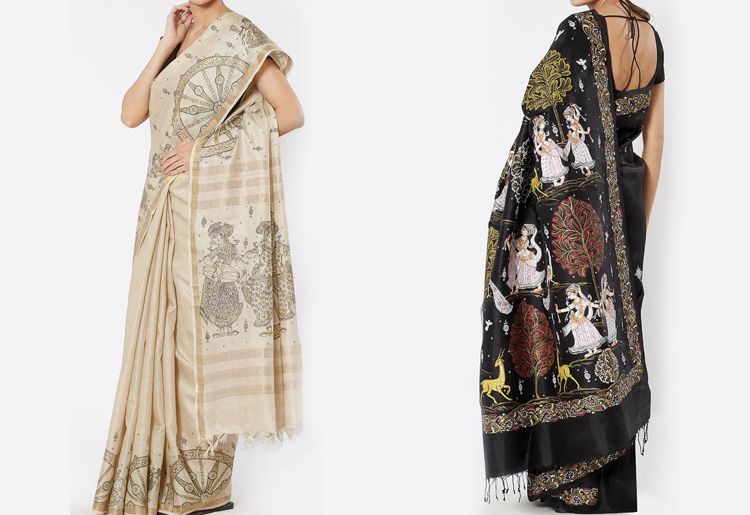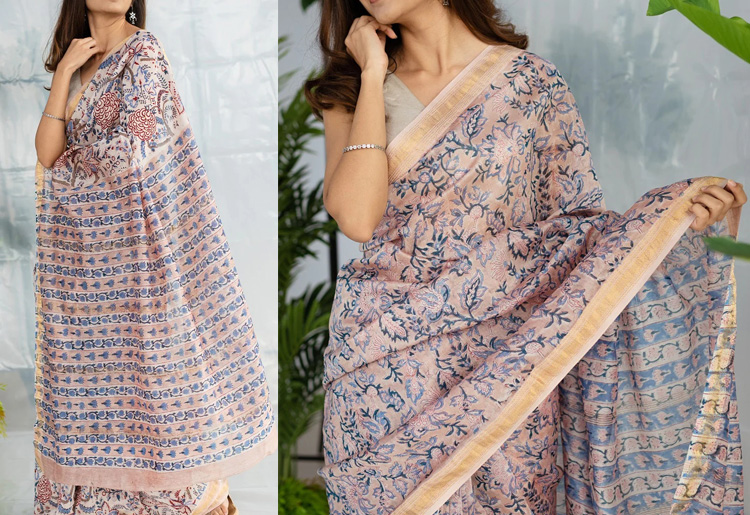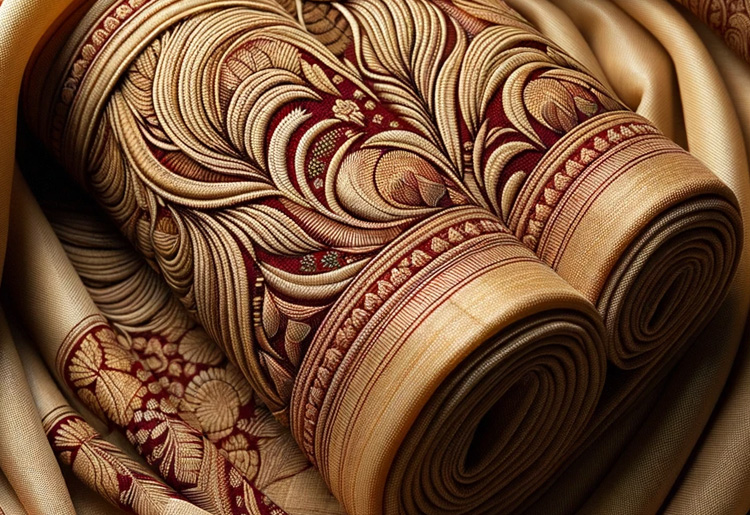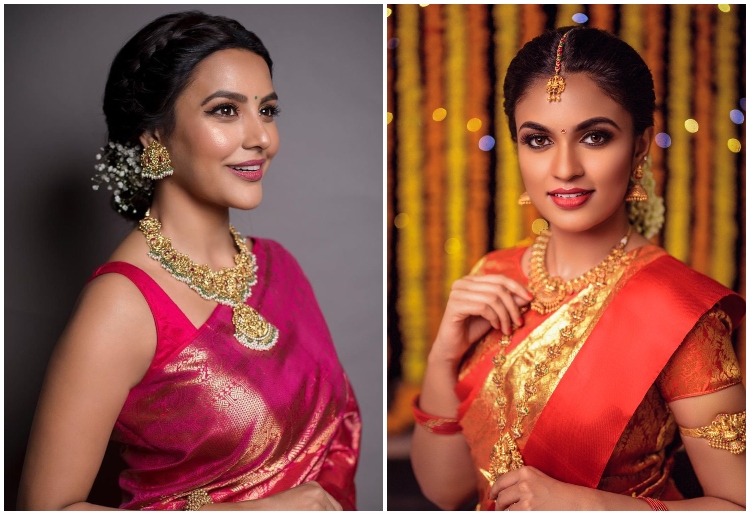The saree, a traditional Indian garment, holds significant cultural and regional importance. With its diverse variety and unique designs, sarees showcase the rich heritage and craftsmanship of India. From the elegant Banarasi saree to the vibrant kanjivaram saree, there are numerous types of sarees that reflect the distinct styles and traditions of different regions in India.
Known for its opulent gold and silver brocade work, the Banarasi saree is a classic choice for weddings and special occasions. The kanchipuram saree, typically woven in silk and decorated with intricate motifs, epitomizes the artistry of South Indian weavers. Chanderi sarees, on the other hand, are lightweight and crafted from a blend of silk and cotton, known for their sheer elegance.
Tussar silk sarees from Bihar and Jharkhand are loved for their natural texture and earthy colors, while Patola sarees from Gujarat are known for their vibrant geometric patterns. Bandhani sarees, famous in Rajasthan and Gujarat, feature tie-and-dye patterns created by skilled artisans. Paithani sarees from Maharashtra are renowned for their intricate borders and peacock motifs.
Each region in India has its own unique saree styles and weaving techniques. From the delicate Jamdani sarees of West Bengal to the Kota Doria sarees of Rajasthan, the diversity is immense. The intricately embroidered Chikankari sarees, originating from Lucknow in Uttar Pradesh, are a symbol of grace and charm. Maheshwari sarees from Madhya Pradesh exhibit a harmonious blend of silk and cotton, while Sambalpuri sarees from Odisha are known for their vibrant traditional motifs.
The Assam Silk sarees, made from indigenous silk, reflect the rich cultural heritage of Assam. Baluchari sarees from West Bengal feature exquisite woven depictions of mythological scenes. Muga silk sarees, also from Assam, are known for their glossy texture and golden motifs.
These are just a few examples of the diverse range of sarees found in India. Each saree tells a story, representing the unique traditions and craftsmanship of its region. In addition to the individual saree types, there are also regional and traditional variations that further contribute to the richness and variety of Indian sarees. From the South Indian sarees known for their vibrant colors and temple designs to the graceful drapes of North Indian sarees, they all have their own distinctive charm.
Exploring the world of sarees in India is an enchanting journey that celebrates the beauty of traditional textiles and craftsmanship. Whether you choose a saree for a festive occasion or as part of your everyday wardrobe, it is a garment that truly encapsulates the essence of Indian culture and heritage.
Types of Sarees in India
India is a treasure trove of diversity when it comes to sarees. From the rich and regal Banarasi to the vibrant and graceful Bandhani, these sarees showcase the exquisite traditions and craftsmanship of different regions. In this section, we will explore the captivating world of sarees in India. We will delve into the beauty and uniqueness of each specific saree type, from the resplendent kanchipuram to the intricate Chikankari. Let’s embark on a journey through the kaleidoscope of colours, patterns, and stories that adorn these 46 types of sarees.
1. Banarasi Saree
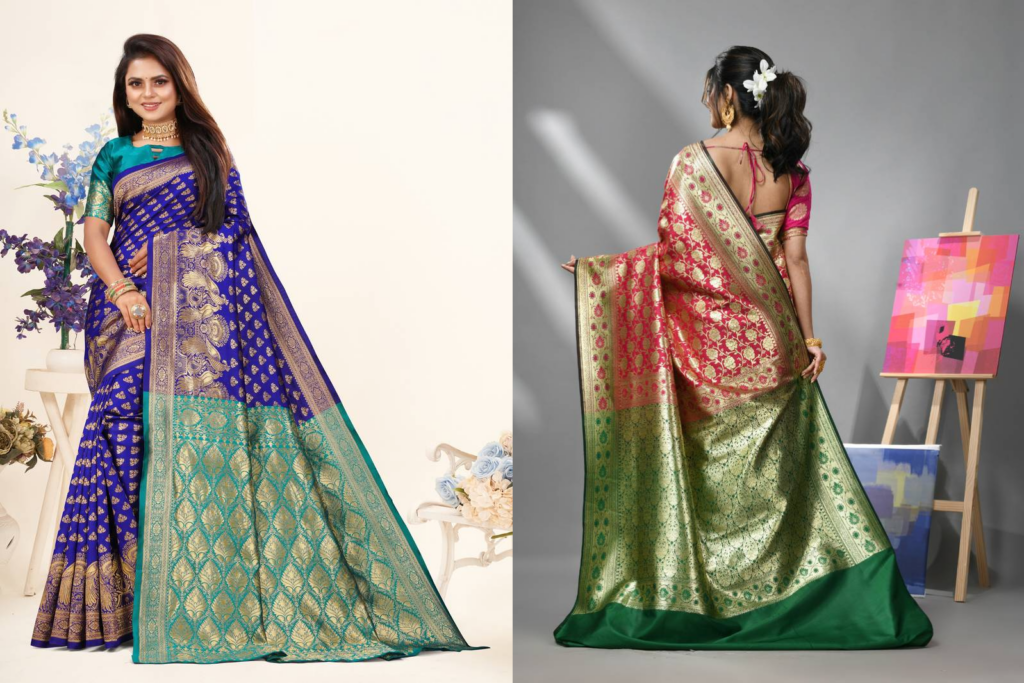
The Banarasi saree is a traditional and highly coveted type of saree that originates from the city of Varanasi, India. It is known for its intricate designs, opulent silk fabric, and stunning craftsmanship. The Banarasi saree is typically made with pure silk and is adorned with elaborate motifs and patterns such as brocade, zari, and meenakari work.
The Banarasi saree is a symbol of elegance and luxury, making it a popular choice for weddings and other special occasions. It is often characterized by its heavy embellishments and rich colours, such as gold, silver, and vibrant shades of red, green, and blue.
One of the distinguishing features of the Banarasi saree is its use of the finest quality silk, which gives it a lustrous and regal appearance. The craftsmanship involved in creating a Banarasi saree is exceptional, with artisans employing traditional weaving techniques that have been passed down through generations.
The Banarasi saree is considered a timeless classic in Indian fashion, and it continues to be highly sought after both within India and internationally. Whether worn by a bride on her wedding day or by a woman attending a festive celebration, the Banarasi saree is a true symbol of Indian heritage and craftsmanship.
2. Kanchipuram Saree
Kanjivaram sarees are a popular type of saree from the Indian state of Tamil Nadu. They are known for their exquisite craftsmanship and luxurious silk fabric. kanchipuram sarees are traditionally handwoven by skilled craftsmen using pure mulberry silk and gold zari threads. The intricate designs and motifs on the sarees reflect the rich cultural heritage of the region.
These sarees are characterised by their vibrant colours, heavy borders, and intricate pallus. The zari work on kanjivaram sarees is often inspired by traditional motifs like temple borders, checks, and paisleys. These sarees are considered to be a symbol of elegance and grace and are often worn by women on special occasions like weddings and festivals.
The history of kanjivaram sarees dates back several centuries. It is believed that the silk weaving tradition in Kanchipuram, the town where these sarees originated, was established during the reign of the Chola dynasty. Over the years, the art of weaving kanjivaram sarees has been passed down from one generation to another, ensuring its preservation and continuation. Today, Kanchipuram sarees are not only cherished in India but are also admired and sought after by women across the world for their beauty and timeless appeal.
3. Chanderi Saree
The Chanderi saree is a traditional Indian garment that originated in the town of Chanderi in Madhya Pradesh, India. It is known for its lightweight and sheer texture, making it a popular choice for formal occasions and summer wear. Here are some key characteristics and details about the Chanderi saree:
- Fabric: Chanderi sarees are typically made from a blend of silk and cotton or pure silk. They have a glossy texture and a delicate feel.
- Designs: Chanderi sarees are known for their beautiful motifs, which are often inspired by nature, such as flowers, birds, and geometric patterns. The designs are usually woven or printed onto the fabric.
- Color Palette: Chanderi sarees come in a wide range of colours, including pastels, vibrant shades, and metallic hues, allowing for various styling options.
- Embellishments: Some Chanderi sarees feature embellishments like zari work (gold and silver thread), sequins, and beads, adding an extra element of elegance to the attire.
- Draping Style: The Chanderi saree is typically draped in the Nivi style, which involves pleating the fabric and arranging it over the shoulder.
The Chanderi saree is a timeless and elegant choice that embodies the rich cultural heritage of India. Its intricate craftsmanship and lightweight fabric make it a favourite among women of all ages, offering a perfect blend of tradition and modernity.
4. Tussar Silk Saree
Tussar Silk Saree is a type of saree known for its rich texture and natural golden color. It is made from silk produced by silkworms that feed on trees like oak and arjun. Tussar silk sarees are popular for their versatility and can be worn for both formal and casual occasions. These sarees are known for their unique and intricate designs, including tribal and nature-inspired motifs. Tussar silk sarees are lightweight and breathable, making them comfortable to wear throughout the year. They are also known for their durability and can last a long time if cared for properly. The tussar silk saree industry provides employment to numerous weavers, especially in regions like Bihar, Jharkhand, and West Bengal. These sarees are often adorned with zari work, sequins, and embroidery to enhance their beauty. Tussar silk sarees are a perfect choice for those who appreciate the elegance of silk with a touch of rustic charm. They are available in a wide range of colors and designs to suit different preferences and occasions.
5. Patola Saree
The Patola Saree is a traditional and highly coveted handwoven saree from Gujarat, India. It is known for its vibrant colours and intricate designs. The Patola Saree is created using a double ikat technique, where both the warp and weft threads are resist-dyed before weaving, resulting in a reversible fabric.
The Patola Saree is characterised by its geometric motifs, including flowers, animals, and human figures. It often features contrasting colours and fine details, making it a statement piece for special occasions. The weaving process is labour-intensive and time-consuming, with skilled artisans spending months to create a single saree.
To ensure the authenticity of a Patola Saree, look for the “GI” tag, indicating it is a genuine handloom product. Patola Sarees are often passed down through generations and treasured as heirlooms. They are timeless and can be paired with a variety of blouses and accessories to create a unique and elegant look.
Consider owning a Patola Saree to showcase the rich cultural heritage of Gujarat and add a touch of tradition and sophistication to your wardrobe.
6. Bandhani Saree
- The Bandhani Saree is a traditional Indian garment renowned for its vibrant colours and intricate tie-dye patterns.
- Originating from the state of Gujarat, Bandhani Sarees are created by tying numerous small knots on the fabric before dyeing to produce unique patterns.
- The technique used in crafting Bandhani Sarees involves a resist-dyeing method, where the tied knots resist the dye and form beautiful designs.
- Bandhani Sarees are typically made from lightweight fabrics such as cotton, silk, or chiffon, making them ideal for wearing in warm weather.
- These sarees are popular choices for festive occasions like weddings and celebrations, as they emit a festive and joyful atmosphere.
- Bandhani Sarees showcase a variety of patterns, including dots, waves, and squares, which are meticulously created by skilled artisans.
- Each Bandhani Saree is a masterpiece, showcasing the craftsmanship and creativity of the artisans who craft them.
- These sarees are often embellished with sequins, beads, or zari work, enhancing their beauty.
7. Paithani Saree
Paithani saree is a traditional silk saree from Maharashtra, India. It is renowned for its vibrant colours, intricate designs, and exquisite zari work. The saree is named after the town of Paithan, where it originated. Paithani sarees are woven with pure silk and the motifs are inspired by the art and culture of the region.
These sarees are known for their borders adorned with peacock and lotus motifs. The body of the saree features intricate designs of flowers, birds, and geometric patterns. Paithani sarees are considered a symbol of prestige and are often worn on special occasions like weddings and festivals.
Historically, Paithani sarees were favoured by royalty and were considered a luxury item. The art of weaving Paithani sarees has been passed down through generations, and skilled artisans continue to weave them today. Their craftsmanship and timeless beauty make Paithani sarees a cherished treasure in Indian fashion and textile heritage.
8. Jamdani Saree
When it comes to traditional sarees in India, the Jamdani saree holds a special place. Known for its intricate designs and lightweight fabric, the Jamdani saree is a popular choice for formal occasions and weddings. This saree is traditionally woven with cotton and features beautiful motifs and patterns created using the supplementary weft technique. The specialty of the Jamdani saree lies in its hand woven craftsmanship, which takes skilled artisans weeks or even months to complete a single piece.
The Jamdani saree has a rich history and is believed to have originated in Bangladesh. It became popular among the Mughal nobility and later spread to various parts of India. Today, Jamdani sarees continue to be cherished for their exquisite craftsmanship and timeless elegance.
Story:
In a small village in West Bengal, a group of weavers gather every day to create beautiful Jamdani sarees. Among them is Rina, a skilled weaver who learned the art from her mother. Rina takes pride in her work and believes that each saree tells a unique story. One day, a bride-to-be visited their village in search of the perfect Jamdani saree for her wedding. Rina and her fellow weavers spent days meticulously weaving a saree that embodied the bride’s dreams. When the bride finally tried on the saree, she was overwhelmed with joy. The intricate patterns and delicate craftsmanship left her in awe. Rina smiled, knowing that her saree would be a treasured heirloom, passed down through generations, carrying with it the story of a love-filled wedding day.
9. Kota Doria Saree
Kota Doria saree, also known as Kota Dori, is a traditional handwoven saree from Kota, Rajasthan, India. It is made using a unique blend of cotton and silk fibres, making it lightweight and ideal for hot and humid weather. The saree is known for its fine texture and delicate weave, which gives it a translucent appearance. Kota Doria sarees are characterised by their distinctive square-shaped patterns, known as “khats,” which are typically woven in contrasting colours. These sarees are often embellished with intricate motifs and embroidery work. The history of Kota Doria sarees dates back to the Mughal era when they were traditionally crafted for royalty. Over time, they have gained popularity among women across India and are now considered a timeless fashion statement. Today, Kota Doria sarees are highly sought after for their elegance and versatility. They are often worn for special occasions and festivals, as well as casually for everyday wear. The lightweight fabric and intricate craftsmanship make Kota Doria sarees a favourite among women who appreciate traditional handwoven textiles.`
10. Pochampally Saree
The Pochampally Saree, also known as the Pochampally Ikat saree, is a traditional handwoven saree that originates from the town of Pochampally in Telangana, India. It is famous for its intricate designs and vibrant colours, which are achieved through the unique Ikat dyeing and weaving technique.
Here are some features of the Pochampally Saree:
- Artistic Patterns: Pochampally sarees feature exquisite geometric and abstract patterns that are meticulously woven into the fabric.
- Ikat Technique: The saree is created using the Ikat technique, where the yarns are tie-dyed before weaving, resulting in the characteristic blurred edges and rich colour combinations.
- Natural Fabrics: Pochampally sarees are predominantly made from silk and cotton, ensuring comfort and breathability.
- Broad Borders: The saree often has broad, contrasting-coloured borders with intricate designs, adding a touch of elegance.
A friend of mine recently wore a Pochampally saree to a wedding, and she received many compliments on the unique and vibrant design. She shared how she felt a sense of pride wearing a saree that showcased the rich cultural heritage of India.
11. Chikankari Saree
Chikankari sarees are a popular type of saree known for their intricate embroidery work originating from Lucknow, India. These sarees are crafted with delicate white thread and are available in various fabrics like cotton, georgette, and chiffon. The embroidery on Chikankari sarees typically features flowers, paisleys, and intricate patterns, adding a touch of elegance and grace to the garment. Chikankari sarees are lightweight, making them comfortable to wear, and are often adorned with sequins or pearls for added beauty. These sarees are a perfect choice for special occasions like weddings, festivals, or parties.“`
I remember attending a wedding where the bride wore a stunning Chikankari saree. The intricate embroidery work and the soft pastel colour of the saree made her look like a vision. It was fascinating to see the attention to detail and the craftsmanship that went into creating such a masterpiece. The bride received numerous compliments throughout the evening, and it was evident that the Chikankari saree added an aura of elegance and sophistication to her overall look. It was truly a sight to behold and a testament to the beauty and charm of Chikankari sarees.
12. Maheshwari Saree
The Maheshwari Saree is a traditional Indian saree that originated in the town of Maheshwar in Madhya Pradesh. It is known for its unique combination of cotton and silk, vibrant colours, delicate zari or brocade work, and distinctive borders called “pallus.”
What makes the Maheshwari saree stand out is its reversible quality, with different designs on the front and back. This saree showcases intricate motifs such as peacocks, flowers, and geometric patterns. The pallu of the saree often features a striped or checked design.
Maheshwari sarees are lightweight, comfortable, and suitable for both formal and casual occasions. They are popular across India and are worn by women of all ages.
I once attended a wedding where the bride wore a beautiful Maheshwari saree. The saree’s rich colours and elegant zari work were stunning, and the bride looked radiant. Throughout the ceremony, she received numerous compliments on her choice of attire. It was a wonderful example of how the Maheshwari saree can truly enhance a woman’s beauty on her special day.
13. Sambalpuri Saree
The Sambalpuri saree is a traditional handwoven saree from the state of Odisha in India. It is known for its unique and intricate ikat patterns, created using the tie-and-dye technique. The saree is made using high-quality cotton or silk yarns, which give it a luxurious feel and drape.
The Sambalpuri saree is characterised by its vibrant colours and rich motifs, inspired by nature and local culture. It often features traditional designs such as flowers, birds, and geometric patterns. The saree is highly valued for its craftsmanship and the skill of the weavers who create it.
The Sambalpuri saree is a popular choice for special occasions and festivals in Odisha and other parts of India. It represents the cultural heritage and artistic traditions of the region. With its timeless beauty and exquisite craftsmanship, the Sambalpuri saree is favoured by women who appreciate the intricacy and elegance of traditional handwoven textiles.
A woman from Odisha wore a stunning Sambalpuri saree on her wedding day. The saree, handwoven by a skilled weaver, featured intricate ikat patterns in vibrant colours. As she walked down the aisle, she felt pride in wearing a saree that represented her cultural heritage. The Sambalpuri saree made her wedding day even more special, and she received many compliments on its beauty and craftsmanship. The saree became a treasured heirloom, passed down through generations, keeping the tradition and artistry of Sambalpuri weaving alive.
14. Assam Silk Saree
Assam Silk Saree is a traditional Indian saree known for its exquisite craftsmanship and rich cultural heritage. This saree is hand-woven in Assam, a northeastern state of India known for its silk production. The Assam Silk Saree is made from Muga silk, which is a special type of silk unique to Assam. Muga silk has a natural golden hue, giving the saree a distinct and royal appeal.
The Assam Silk Saree is adorned with intricate motifs and designs inspired by nature, such as flowers, birds, and animals. The saree is known for its durability and lustrous texture, making it a perfect choice for special occasions and festivities.
The Assam Silk Saree has gained international recognition and is highly valued for its craftsmanship and quality. It is a symbol of elegance, grace, and cultural heritage. When wearing an Assam Silk Saree, one can exude timeless beauty and showcase the rich craftsmanship of India.
So, if you are looking for an elegant and traditional saree that reflects the cultural heritage of Assam, the Assam Silk Saree is a perfect choice.
15. Baluchari Saree
The Baluchari saree is a traditional Indian saree known for its intricate and elaborate designs. Originating from the region of Baluchar in West Bengal, this saree is popular among women for its craftsmanship and unique patterns. It is usually made of silk and features detailed motifs depicting mythological scenes, nature, or historical events.
The Baluchari saree is highly regarded for its rich and vibrant colours, often using contrasting hues to create a visually striking effect. The borders and pallu (the loose end of the saree) are adorned with ornate patterns, adding to its elegance and charm.
Wearing a Baluchari saree is considered a symbol of cultural heritage and sophistication. It is commonly worn on special occasions such as weddings, religious ceremonies, and cultural events. The intricate motifs and fine silk fabric make the Baluchari saree a prized possession for many women in India.
The Baluchari saree showcases the traditional craftsmanship and artistry of West Bengal and continues to be cherished for its timeless beauty and cultural significance.
16. Muga Silk Saree
The Muga Silk Saree is a traditional and highly prized silk saree from the region of Assam, India. It is made from the unique and rare Muga silk, which is known for its brilliant natural golden color. This saree is a symbol of prestige and elegance. The Muga silk is produced by the Antheraea assamensis caterpillar, which feeds on the leaves of the Som and Sualu trees. The Muga Silk Saree is known for its lustrous texture and durability. It is often adorned with intricate traditional designs and motifs, reflecting the rich cultural heritage of Assam. Skilled artisans handweave a saree using age-old techniques that have been passed down through generations. Wearing a Muga Silk Saree not only showcases the beauty of Assamese craftsmanship but also supports the local weavers and the preservation of their traditional skills. Whether worn for special occasions or cherished as a heirloom, the Muga Silk Saree is a true symbol of Indian craftsmanship and ethereal beauty.
17. Narayanpet Saree
Narayanpet saree, originating from the town of Narayanpet in the Indian state of Telangana, is known for its vibrant colours and traditional designs. Here are some key features to consider when choosing a Narayanpet saree:
| Handwoven Beauty | Cotton and Silk Blend | Distinctive Borders | Rich Colour Palette | Perfect for Festive Occasions |
| Narayanpet sarees are handwoven by skilled artisans, using traditional techniques that have been passed down through generations. | These sarees are crafted using a blend of cotton and silk threads, giving them a unique texture and lustre. | One of the highlights of Narayanpet sarees is their contrasting borders, featuring intricate motifs and geometric patterns. | Narayanpet sarees are available in a wide range of colours, including bold shades like red, green, and blue, as well as more subtle pastel hues. | With their vibrant colours and ornate designs, Narayanpet sarees are popular choices for weddings, festivals, and other special events. |
If you’re looking to add a touch of tradition and elegance to your wardrobe, consider choosing a beautiful Narayanpet saree.
18. Gadwal Saree
The Gadwal Saree is a traditional handwoven saree that originated in Gadwal, a town in Telangana, India. This saree is known for its unique and exquisite weaving technique, known as the “Kupadam” style. It is characterised by a silk body with a cotton border and pallu, making it lightweight and easy to drape.
The Gadwal Saree is adorned with intricate designs inspired by nature, including temple borders, peacock motifs, and geometric patterns. It is also known for its vibrant colour combinations and use of zari, which adds a touch of elegance.
What sets the Gadwal Saree apart is its distinctive reversible feature. One side of the saree showcases a plain weave, while the other side features intricate designs. This allows the wearer to choose their desired look based on the occasion or personal preference.
Gadwal Sarees are highly prized and make a valuable addition to any saree collection. Their timeless beauty and craftsmanship have made them popular among women across India and beyond.
19. Konrad Saree
The Konrad saree, also known as the temple saree, is a traditional garment that originates from the state of Tamil Nadu in South India. It derives its name from the town of Kumbakonam and is closely associated with temple rituals and ceremonies. It distinguishes the Konrad saree is its exquisite and intricate gold zari work, which showcases traditional motifs such as peacocks, elephants, and flowers. The saree is typically woven using pure silk and features a wide border and pallu (the loose end of the saree) adorned with these beautiful designs.
The Konrad saree holds great reverence due to its rich history and cultural significance. It is considered auspicious and is often worn by brides during their wedding ceremonies. The handloom weavers in Tamil Nadu meticulously create each saree, ensuring a masterpiece that embodies the region’s weaving traditions and craftsmanship.
If you are in search of a piece of art that embodies tradition, grace, and elegance, the Konrad saree is an ideal choice. Its timeless beauty and cultural significance make it a cherished possession for generations to come.
20. Kantha Saree
The Kantha saree is a traditional Indian garment known for its unique embroidery technique. Originating from the state of West Bengal, the Kantha saree is made by stitching together layers of old sarees or fabric scraps. The intricate running stitch embroidery adds charm and character to the saree, giving it a distinct look.
The Kantha saree is perfect for those looking for a combination of elegance and comfort. It is lightweight and drapes beautifully, making it ideal for both formal and casual occasions. The vibrant colours and intricate designs make the Kantha saree a true work of art.
To style a Kantha saree, pair it with traditional jewellery and a matching blouse. You can also experiment with different draping styles to create a unique look. Whether you’re attending a wedding or a festive celebration, the Kantha saree is sure to make you stand out in the crowd.
So, if you’re a lover of traditional Indian textiles, don’t miss out on the beauty of the Kantha saree. Embrace the rich history and craftsmanship of this exquisite garment and make a fashion statement wherever you go.
21. Bomkai Saree
The Bomkai saree, also known as Sonepuri saree, is a traditional hand-woven garment from Odisha, India. It is named after the village of Bomkai, where it originated. This saree is characterized by its intricate designs, vibrant colours, and unique weaving techniques. The Bomkai saree is usually made from cotton or silk, with a combination of both materials known as Sonepuri silk saree. The designs on the saree often depict traditional motifs, mythical creatures, and cultural symbols. The border and pallu (the loose end of the saree) are adorned with heavy embellishments and intricate patterns. These sarees are highly valued for their craftsmanship and the skill of the weavers. They are often worn for special occasions such as weddings, festivals, and cultural events. When buying a Bomkai saree, consider the quality of the fabric, the intricacy of the designs, and the authenticity of the craftsmanship. Look for trusted sellers or stores that specialize in traditional Indian garments. The Bomkai saree is a beautiful and unique piece of Indian traditional attire. Its intricate designs and vibrant colours make it a popular choice for special occasions. Consider adding this exquisite saree to your collection for a touch of traditional elegance.
22. Ilkal Saree
The Ilkal Saree is a traditional saree from the state of Karnataka in India. It is renowned for its distinctive weaving technique and beautiful design patterns. The saree is characterised by its unique pallu, which is made of contrasting colours and features intricate motifs. The body of the saree is usually plain or adorned with simple patterns.
Ilkal sarees are crafted using a blend of cotton and silk threads, giving them a soft and comfortable texture. They are lightweight and easy to drape, making them ideal for both everyday wear and special occasions.
The saree is traditionally worn with a special type of blouse called the ‘shawl blouse,’ which is also made using the same weaving technique as the saree.
Ilkal sarees have a rich history and are considered a symbol of pride and culture in the region. They are treasured by women for their elegance and timeless beauty.
True story: A young woman named Priya inherited a beautiful Ilkal saree from her grandmother. She was thrilled to wear it on her wedding day, as it symbolised her family’s heritage. The saree had been passed down through generations and held sentimental value. Priya felt a sense of pride and connection to her roots as she embraced the traditions of her ancestors while wearing the Ilkal saree. It was a truly special and memorable moment for her and her family.
23. Ghicha Saree
The Ghicha Saree is a traditional Indian saree known for its unique texture and rustic charm. Made from hand-spun yarn, it features a rough, coarse texture that adds to its appeal. Ghicha sarees are woven in various regions of India, including Bihar, Jharkhand, and West Bengal. The Ghicha saree derives its name from the Ghicha silk, which is obtained from the cocoons of wild silkworms. These sarees are often adorned with beautiful motifs and designs, adding to their overall elegance. The Ghicha saree is highly versatile and can be worn for both casual and formal occasions. It is favoured by many for its comfortable feel and ability to drape easily. Ghicha sarees are known for their durability and can last for many years if properly cared for. For those looking to embrace traditional Indian fashion, the Ghicha saree is an excellent choice. Its rustic charm and unique texture make it a standout piece in any wardrobe. Pair your Ghicha saree with traditional jewellery and a stylish blouse to complete the look. Experiment with different draping styles to create a unique and personalised ensemble. Embrace the rich cultural heritage of India by incorporating the Ghicha saree into your wardrobe.
24. Kosa Silk Saree
The Kosa Silk Saree is a beautiful and traditional garment originating from Chhattisgarh, India. It is known for its intricate designs and luxurious texture. The saree is named after the silk fabric used, which is made from the cocoon of the Antheraea mylitta moth. This silk is highly valued for its natural lustre and durability.
The Kosa Silk Saree is typically adorned with intricate motifs and patterns, often inspired by nature and local traditions. The vibrant colours and exquisite craftsmanship make it a favourite choice for special occasions and celebrations.
The saree also holds cultural significance in Chhattisgarh, where it is considered a symbol of grace and elegance. It is often passed down through generations, representing the rich heritage of the region.
Whether worn by brides, festival-goers, or anyone who appreciates its beauty, the Kosa Silk Saree is a timeless and cherished attire in Indian fashion.“`
25. Tant Saree
Tant saree is a traditional Indian saree variety known for its light and airy fabric. It originated in West Bengal and is made using the traditional handloom technique. The saree is typically woven with cotton threads, giving it a soft and comfortable feel. Tant sarees are characterized by their wide and colourful borders, intricate woven motifs, and delicate patterns. They are known for their versatility and can be worn for both casual and formal occasions. The lightweight fabric makes it ideal for hot and humid climates. Tant sarees come in a wide range of colours and designs, allowing women to choose according to their preferences and occasions. Whether it’s a simple cotton tant saree for everyday wear or an elaborately designed one for special events, this traditional saree never fails to make a statement.
Fact: Tant sarees are also known as “Bengal cotton sarees” and have been a popular choice among women in West Bengal for centuries.
26. Garad Saree
The Garad saree is a popular traditional saree from West Bengal, India. This saree is known for its simplicity and elegance, making it a preferred choice for various occasions. Garad sarees are typically made from lightweight silk fabric, with a plain body and a contrasting coloured border. The colours used in these sarees are usually vibrant and rich, adding to their beauty.
One unique feature of the Garad saree is its absence of intricate or heavy embroidery work. Instead, it is adorned with simple and delicate designs, such as small motifs or floral patterns. These minimalistic designs give the saree a classic and timeless appeal.
Garad sarees are often worn during auspicious festivals, religious ceremonies, weddings, and other traditional events. They are also seen as a symbol of cultural identity and pride.
Pro-Tip: When wearing a Garad saree, pair it with traditional gold jewellery and a matching blouse to enhance its charm and grace.
27. Dhakai Jamdani Saree
The Dhakai Jamdani saree is a traditional handloom saree from Bangladesh that is highly regarded for its intricate designs and fine craftsmanship. It is woven with cotton and occasionally silk threads, creating a lightweight and breathable fabric perfect for the hot and humid climate of the region. The saree is characterised by its unique motifs, which are meticulously woven into the fabric using a supplementary weft technique. These motifs often include floral patterns, geometric shapes and figurative designs. The saree is known for its sheer elegance and luxurious feel, making it a popular choice for special occasions and weddings. Dhakai Jamdani sarees are considered a symbol of cultural heritage and are highly sought after for their exquisite craftsmanship. Fun fact: Did you know that it can take several months to create a single Dhakai Jamdani saree due to the labour-intensive process of weaving the intricate motifs?
28. Patan Patola Saree
The Patan Patola Saree is a traditional handwoven saree from Gujarat, India. It is renowned for its exquisite craftsmanship and vibrant colours. Skilled artisans painstakingly create each Patan Patola saree using the double ikat technique, where both the warp and weft threads are tie-dyed before weaving. This intricate process ensures that the designs on the saree are perfectly aligned on both sides, creating a mirrored effect.
The Patan Patola Saree is typically made from silk and features intricate geometric and floral patterns. The saree is highly valued and is often considered a symbol of wealth and prestige.
When purchasing a Patan Patola Saree, it is important to consider the authenticity of the saree and the reputation of the weaver. Genuine Patan Patola sarees can be quite expensive due to the extensive craftsmanship involved. Look for the “Gujarat Handloom and Handicrafts Development Corporation” label, as it guarantees the saree’s authenticity.
The Patan Patola Saree is a beautiful representation of Indian textile heritage and is a must-have for saree enthusiasts.
29. Leheriya Saree
A Leheriya saree is a traditional Indian garment known for its unique tie-dye pattern. Originating from Rajasthan, this saree is crafted using a technique that involves tying the fabric in a specific pattern before dyeing it. The result is a beautiful, wave-like design that gives the saree its name, as “leher” means wave in Hindi.
The Leheriya saree is typically made using lightweight fabrics such as chiffon or georgette. It is known for its vibrant colours and bold patterns, making it a popular choice for festive occasions and celebrations. The saree is usually adorned with embellishments and intricate embroidery, further enhancing its beauty.
In addition to its aesthetic appeal, the Leheriya saree also holds cultural and historical significance. It is a symbol of traditional Rajasthani fashion and is often worn during festivals like Holi and Teej. The saree represents the rich heritage and craftsmanship of Rajasthan, making it a cherished attire in Indian culture.
30. Kotpad Saree
The Kotpad Saree is a traditional handloom saree from the state of Odisha, India. It is renowned for its unique characteristics and intricate weaving techniques. The saree is named after the village of Kotpad, where it originated.
The Kotpad Saree is crafted from organic cotton dyed using natural dyes extracted from the roots of the Aul tree. The process of dyeing the yarn takes several days, and the colours used are predominantly earthy tones such as brown, maroon, and black. The motifs and designs on the saree often depict tribal art and symbols, showcasing the rich cultural heritage of the region.
These sarees are lightweight, breathable, and comfortable to wear, making them ideal for hot and humid climates. They are also renowned for their durability and longevity.
The Kotpad Saree has gained recognition for its eco-friendly and sustainable production methods. It serves as a testament to the skill and craftsmanship of the weavers from the Kotpad region. When you choose a Kotpad Saree, you not only embrace a beautiful piece of traditional clothing but also support the preservation of a cultural art form.
31. Bishnupuri Silk Saree
The Bishnupuri Silk Saree is a traditional Indian saree known for its elegance and rich heritage. Crafted in the town of Bishnupur in West Bengal, these sarees are made from pure silk and are characterised by their exquisite craftsmanship and intricate designs.
- Material: The Bishnupuri Silk Saree is made from pure silk, which gives it a lustrous and smooth texture.
- Designs: These sarees are known for their stunning and intricate designs, including traditional motifs like florals, paisleys, and geometric patterns.
- Colours: Bishnupuri Silk Sarees are available in a wide range of vibrant and rich colours, making them suitable for various occasions.
- Lightweight: Despite being made from silk, these sarees are lightweight and easy to drape, making them comfortable to wear for long durations.
- Occasions: Bishnupuri Silk Sarees are commonly worn during festive occasions, weddings, and other traditional events.
Fun Fact: The weaving of Bishnupuri Silk Sarees is a traditional art form that has been passed down through generations, and each saree takes several days to be completed.
32. Phulkari Saree
The Phulkari saree is a traditional Indian garment that is known for its vibrant embroidery work. Originating from the Punjab region, Phulkari sarees are popular for their intricate floral patterns created using colourful threads. The term “Phulkari” translates to “flower work,” which perfectly describes the essence of this saree.
The Phulkari sarees are typically made on a handloom using cotton or silk fabric. The embroidery is done by hand, and it takes skilled artisans several hours to create a single Phulkari saree. The embroidery motifs vary, ranging from geometric patterns to intricate floral designs.
Phulkari sarees are often worn during special occasions such as weddings, festivals, and cultural events. They are cherished for their vibrant colours and exquisite craftsmanship, reflecting the rich heritage of Punjab.
Pro-tip: When styling a Phulkari saree, keep the accessories minimal to let the beauty of the embroidery stand out. Pair it with traditional Punjabi juttis (handcrafted leather shoes) and a statement clutch to complete the look.“`
33. Kani Saree
The Kani saree is a traditional Indian saree known for its intricate and beautiful designs. It originates from the region of Kashmir and is woven using a special technique called the Kani weaving technique. The Kani saree is characterised by its vibrant colours, intricate patterns, and use of fine silk fabric. It is often adorned with motifs inspired by nature, such as flowers, birds, and paisleys. The Kani saree is a favourite among brides and is worn on special occasions like weddings and festivals. It is known for its exquisite craftsmanship and is considered a luxury item. The Kani saree is highly sought after for its unique beauty and has become a symbol of Indian art and culture. If you are looking for a saree that showcases traditional craftsmanship and elegance, the Kani saree is a perfect choice.
34. Kasavu Saree
The Kasavu Saree is a traditional garment from Kerala, India. Here is some important information about this unique saree:
- Materials: Kasavu sarees are made from handloom cotton. The fabric is usually cream or off-white in colour.
- Design: These sarees have a distinctive gold border called the ‘kasavu.’ The border is woven with golden threads, which adds an elegant touch to the saree.
- Occasions: Kasavu sarees are commonly worn during festivals, special occasions, and traditional events in Kerala. They are also popular as bridal wear.
- Accessories: The Kasavu saree is often paired with traditional gold jewellery, such as necklaces, bangles, and earrings, to enhance the overall look.
- Popularity: Kasavu sarees are highly regarded and cherished by women in Kerala. They are a symbol of tradition and cultural pride.
The history of the Kasavu saree dates back hundreds of years. It is believed that these sarees were first worn by the royalty and aristocrats in Kerala. Over time, they became popular among the general population and are now considered an essential part of Kerala’s cultural heritage.
35. Kota Silk Saree
The Kota Silk Saree is a traditional Indian saree that originated in Kota, Rajasthan. It is known for its lightweight and airy fabric, making it a popular choice for summer and hot climates. Here are some key features and facts about this beautiful saree:
| The saree is made of pure silk or silk-cotton blend, woven in a unique translucent weave called “khat” or “kota doria.” | The saree has a distinctive checkered or square-shaped pattern called “khats” or “kota motifs” created by cotton threads. | Kota Silk Sarees are available in a wide range of colours, from vibrant shades to pastel hues. They often feature intricate zari work, block prints or floral designs. | These sarees are versatile and can be worn for both formal and casual occasions. They are particularly popular for summer weddings, festivals and social gatherings. | The lightweight and elegant drape of the saree makes it easy to style in various ways. It can be paired with different blouse designs and accessorised with statement jewellery. |
My friend Priya wore a stunning Kota Silk Saree for her sister’s wedding. The delicate fabric and vibrant colour made her stand out in the crowd. She received numerous compliments on her choice of saree and looked effortlessly elegant throughout the event.
36. Chanderi Silk Saree
Chanderi Silk Saree is a traditional Indian saree renowned for its exquisite texture and sheer elegance. Here are some important features and factors to consider when selecting a Chanderi Silk Saree:
- Material: Chanderi Silk Sarees are crafted from a blend of silk and cotton, providing a lightweight and comfortable feel.
- Designs: These sarees are often embellished with intricate handwoven motifs, including butis, floral patterns, and gold or silver zari work.
- Colour palette: Chanderi Silk Sarees are available in a wide range of colours, including vibrant hues like royal blue, magenta, and emerald green, as well as soft pastels and classic neutrals.
- Occasions: They are suitable for both formal events and casual wear. The luxurious fabric and elegant designs make them ideal for weddings, festivals, and parties.
- Styling: Chanderi Silk Sarees can be paired with traditional jewellery such as gold or silver earrings, bangles, and a statement necklace. They can be draped in various styles, such as the classic Nivi drape or a modern fusion style.
Consider selecting a Chanderi Silk Saree for its timeless beauty and cultural significance. Remember to properly care for the saree to preserve its shine and longevity. Happy shopping!
37. Mysore Silk Saree
Mysore Silk Saree, also known as Mysore Crepe Silk Saree, is a traditional Indian saree known for its exquisite craftsmanship and elegant drape. It is made from pure silk and is known for its smooth texture and lightweight feel. The saree is characterized by its bright and vibrant colours, intricate zari work, and elaborate border designs.
The Mysore Silk Saree is a popular choice for weddings, festivals, and special occasions. It is highly revered in the state of Karnataka, especially in the city of Mysore, where it originated. The silk used in these sarees is sourced locally and is known for its high quality.
The Mysore Silk Saree is often adorned with traditional motifs such as peacocks, flowers, and geometric patterns. It is typically worn with a matching blouse and is draped in a unique and elegant style.
With its rich history and cultural significance, the Mysore Silk Saree is a prized possession for every saree lover. Its timeless beauty and impeccable craftsmanship make it a must-have for any traditional wardrobe.
38. Uppada Silk Saree
Uppada Silk Saree, also known as Uppada Pattu, is a traditional Indian saree that originates from the town of Uppada in Andhra Pradesh. These sarees are known for their exquisite craftsmanship and delicate weaving. Made from pure silk, Uppada sarees are lightweight and have a lustrous texture.
The unique feature of Uppada Silk Sarees is the jamdani weaving technique used to create intricate designs on the fabric. The motifs on these sarees often depict traditional patterns inspired by nature, such as floral and peacock motifs. The sarees are available in a wide range of colours, from vibrant and bold shades to subtle and pastel hues.
Uppada Silk Sarees are a popular choice for special occasions and weddings due to their elegance and fine craftsmanship. They are highly prized for their quality and timeless appeal. The sarees are often adorned with zari work and intricate borders, adding to their richness and beauty.
A woman named Roshni wore an Uppada Silk Saree for her wedding. The intricate weaving and vibrant colours of the saree made her feel like a princess on her special day. The saree was passed down through generations in her family, representing their rich cultural heritage. Roshni felt a deep sense of pride and connection to her roots wearing the Uppada Silk Saree, creating memories that would last a lifetime.
39. Mangalagiri Saree
The Mangalagiri saree is a traditional handloom saree from the region of Mangalagiri in Andhra Pradesh, India. It is known for its unique weaving technique and is crafted with fine cotton fabric, showcasing intricate designs and motifs. The saree is characterised by its distinctive zari border and butta work, which adds elegance and charm to its overall look. It is lightweight and comfortable to wear, making it suitable for all occasions. The Mangalagiri saree is available in a wide range of colours, from vibrant hues to subtle pastels, catering to different tastes and preferences. It is highly valued by saree enthusiasts and collectors as it represents the rich cultural heritage of Andhra Pradesh. Whether worn for weddings, festivals, or formal events, the Mangalagiri saree is a timeless choice that celebrates the traditional craftsmanship of India.
40. Gota Patti Saree
The Gota Patti saree is a traditional Indian saree renowned for its intricate embellishments and vibrant colours. When selecting a Gota Patti saree, there are several key points to consider:
- Design: Gota Patti sarees feature delicate handmade gota work, which involves attaching small pieces of intricately patterned gold or silver fabric to the saree. Look for a design that complements your personal style and the occasion.
- Fabric: Gota Patti sarees are typically made from lightweight fabrics such as chiffon, georgette, or silk. Consider the season and your comfort level when selecting the fabric.
- Colour: Gota Patti sarees come in a wide range of vibrant colours. Choose a colour that complements your skin tone and matches the occasion you’re wearing the saree for.
- Occasion: Gota Patti sarees are often worn for festive occasions such as weddings, festivals, and other celebrations. Consider the event you’ll be attending and choose a saree that fits the dress code.
- Accessorising: Gota Patti sarees are best paired with traditional jewellery like Kundan, Polki, or Meenakari. Choose accessories that enhance the beauty of the saree.
To make your Gota Patti saree stand out, consider pairing it with a contrasting blouse and accessorising with statement jewellery. Embrace the allure of this traditional attire and make a stunning fashion statement.
41. Pattachitra Saree
Pattachitra Saree is a traditional Indian saree that originated in Odisha. It is known for its intricate and colourful hand-painted designs, depicting mythological stories, folk tales, and nature-inspired motifs. The term “Pattachitra” means cloth painting, as the saree is created using a special painting technique on a fabric canvas. The artists use natural dyes and pigments to bring life to their designs.
The Pattachitra Saree is usually made from cotton or silk fabric, and the designs are created using a fine brush and intricate detailing. The colours used in Pattachitra Sarees are vibrant and eye-catching, making them a popular choice for festive and special occasions.
The Pattachitra Saree has gained recognition for its artistic value and cultural significance. It showcases the rich heritage and craftsmanship of Odisha. Many women prefer to wear Pattachitra Sarees to showcase their love for traditional art and to support local artisans. It is a unique and exquisite saree that reflects the beauty of Indian craftsmanship.
42. Sanganeri Saree
The Sanganeri saree is a traditional Rajasthani saree known for its unique block printing technique. It is named after the town of Sanganer in Jaipur, where these sarees are traditionally made. This saree is characterized by intricate motifs and patterns inspired by nature, including flowers, birds, and geometric designs.
The fabric used in Sanganeri sarees is usually lightweight, such as cotton or silk, making it comfortable to wear in the hot climate of Rajasthan. The colours used in these sarees are vibrant and lively, with a combination of bold and pastel shades.
Sanganeri sarees are popular for both casual and formal occasions. They are often adorned with beautiful borders and embellishments, making them a favourite choice for weddings and festivities.
If you are fond of traditional prints and want to add a touch of Rajasthan to your wardrobe, the Sanganeri saree is a perfect choice. Pair it with traditional jewellery and you are ready to make a style statement.
The Sanganeri saree is a timeless piece of art with its intricate block print and vibrant colours, representing the rich culture and heritage of Rajasthan.
43. Kota Jali Saree
The Kota Jali saree is a traditional Indian saree that originated from the city of Kota in Rajasthan, India. It is known for its unique and intricate lattice-like patterns, which are created using the traditional khat weaving technique. The saree is usually made from lightweight and breathable fabric like cotton, making it comfortable to wear in hot and humid climates.
The Kota Jali saree is characterised by its sheer and transparent texture, which is achieved through the weaving process. The lattice patterns not only add a beautiful and delicate design element to the saree but also help in enhancing its breathability. These sarees are often embellished with colourful borders, embroideries, or prints, adding to their charm and appeal.
The Kota Jali saree is popular among women of all ages for various occasions, including formal events, festivals, and daily wear. It is considered a symbol of elegance and grace and is highly sought after for its timeless beauty. Whether paired with traditional or contemporary accessories, the Kota Jali saree is a versatile choice that can elevate any look.
44. Muga Paat Saree
The Muga Paat Saree is a traditional silk saree from Assam, India. It is made from the rare and valuable Muga silk, known for its lustrous texture and durability. The Muga silk is produced by silkworms that feed on Som and Soalu leaves, which are found only in Assam. The saree is characterized by its golden yellow color, which is the natural shade of the Muga silk.
The Muga Paat Saree holds great cultural and historical significance in Assam. It is worn as a symbol of pride and status during special occasions and festivals. The intricate designs and motifs woven into the saree reflect the rich heritage of Assamese craftsmanship.
The Muga Paat Saree has a history dating back over 500 years and continues to be an integral part of Assamese culture. The silk has been highly valued and was once exclusively worn by royalty. Today, it is treasured for its elegance and craftsmanship, representing the tradition and heritage of Assam.
45. Sonepuri Silk Saree
The Sonepuri Silk Saree is a traditional and luxurious saree from Odisha, India. It is known for its exquisite craftsmanship and the use of pure silk fabric. The saree is usually adorned with intricate motifs and vibrant colours, showcasing the rich cultural heritage of the region.
The Sonepuri Silk Saree is characterised by its smooth texture and glossy finish, which is achieved through a special weaving technique. The saree often features traditional designs like peacocks, flowers, and geometrical patterns, which are painstakingly woven by skilled artisans.
The Sonepuri Silk Saree has a long and illustrious history that dates back centuries. It was believed to be patronised by the royalty and aristocracy of Odisha, who appreciated its elegance and fine craftsmanship. Over time, it has become an integral part of Odisha’s cultural identity and continues to be cherished by women for its timeless beauty.
Today, the Sonepuri Silk Saree remains a popular choice for special occasions and festivals, symbolising grace and sophistication. Its intricate weaves and vibrant colours make it a cherished heirloom that is passed down through generations, capturing the essence of tradition and heritage. So, if you’re looking for a saree that combines elegance, artistry, and history, the Sonepuri Silk Saree is an excellent choice.
46. Puttapaka Saree
Puttapaka saree is a traditional Indian saree that originates from the village of Puttapaka in Telangana, India. It is known for its intricate ikat weaving technique, where the yarns are tied and dyed before they are woven, resulting in beautiful and vibrant patterns. The saree is made with natural fibres like cotton or silk, which adds to its durability and comfort. Puttapaka sarees are characterised by their bright colours, geometric patterns, and intricate detailing. The motifs used in the saree often depict various elements of nature like flowers, birds, and animals. These sarees are highly valued for their traditional craftsmanship and unique designs. When wearing a Puttapaka saree, it is common to accessorise with traditional jewellery like gold or silver necklaces, bangles, and earrings. These sarees are often worn during special occasions like weddings, festivals, and cultural events. Puttapaka saree is a stunning example of traditional Indian weaving and craftsmanship. It represents the rich cultural heritage of Telangana and adds elegance and beauty to any occasion. Consider adding a Puttapaka saree to your wardrobe to celebrate the artistry and tradition of India.
Regional and Traditional Variations
Discover the diverse regional and traditional variations of sarees in India. From the vibrant sarees of South India to the intricately designed styles of North India, and the elegant drapes of East India to the timeless designs of the West, each sub-section will take you on a captivating journey through the different saree cultures across the country. Join us as we explore the mesmerizing beauty and unique characteristics of these sarees, showcasing the essence of India’s rich textile heritage.
1. South Indian Sarees
- South Indian Sarees: South Indian sarees are a collection of various types of sarees from different states in South India. These sarees are known for their unique fabric, designs, and motifs.
- Kanchipuram Saree: This is one of the most famous sarees from South India, known for its rich silk fabric and intricate golden zari work.
- Mysore Silk Saree: Originating from Karnataka, these silk sarees are known for their soft texture and vibrant colours.
- Pattu Saree: Also known as the Kancheepuram silk saree, it is a traditional wedding saree from Tamil Nadu, adorned with exquisite designs and motifs.
- Kasavu Saree: A traditional saree from Kerala, kasavu sarees are made from handwoven cotton fabric with a golden border.
- Pochampally Saree: These sarees from Telangana are crafted using the unique Ikat weaving technique, creating geometric patterns in vibrant colours.
- Kota Silk Saree: Known for their light and airy texture, Kota silk sarees from Rajasthan are popular for their fine weave and beautiful zari border.
- Chanderi Silk Saree: Named after the town in Madhya Pradesh, Chanderi silk sarees are known for their sheer texture, intricate motifs, and gold or silver zari work.
- Mangalagiri Saree: Originating from Andhra Pradesh, these sarees are made from pure cotton fabric with intricate zari borders.
If you’re looking for a traditional South Indian saree, consider options like the kanjivaram saree for its luxury and elegance, or the Mysore silk saree for its softness and vibrant colours. The Kasavu saree from Kerala is a great choice for a simplistic yet traditional look. Pochampally sarees are perfect for those who appreciate unique patterns and colours. The Chanderi silk saree and Mangalagiri saree are excellent choices for those who prefer a combination of traditional and contemporary styles.
2. North Indian Sarees
North Indian sarees are known for their exquisite craftsmanship and stunning designs. There is a rich variety of these sarees in North India. Here are some popular North Indian sarees:
- Banarasi Saree: These sarees are known for their intricate brocade work and gold and silver zari. They are a symbol of elegance and opulence.
- Kanjeevaram Saree: Originating from Tamil Nadu but popular in North India as well, Kanjeevaram sarees are known for their rich silk fabric and vibrant colors.
- Chanderi Saree: These sarees are lightweight and ideal for summers. They are known for their sheer texture, hand-woven designs, and zari work.
- Tussar Silk Saree: These sarees are known for their natural gold color and beautiful embroidery. They are perfect for festive occasions.
- Bandhani Saree: These sarees are famous for their tie-dye technique. They feature small dots or shapes created using the resist-dyeing method.
Story: I once attended a wedding in Jaipur, where the bride looked ethereal in a beautiful Banarasi saree. The intricate weaving and shimmering zari work made her stand out, reflecting the beauty and grandeur of North Indian culture.
3. East Indian Sarees
The East Indian region of India is well-known for its exquisite sarees, each with its own unique style and craftsmanship. From the beautiful and intricate Kantha sarees of West Bengal to the vibrant and colourful Sambalpuri sarees of Odisha, here are some notable types of East Indian sarees:
- Kantha Saree
- Bomkai Saree
- Ikkat Saree
- Tant Saree
- Sambalpuri Saree
- Phulkari Saree
- Bishnupuri Silk Saree
- Kasavu Saree
These sarees showcase the rich culture and heritage of the East Indian states. From the exquisite hand embroidery of Kantha sarees to the intricate weaving techniques of Sambalpuri sarees, each saree tells a story and reflects the traditions of the region.
Fun fact: The Kasavu saree, also known as the Kerala saree, is traditionally worn by Malayali women during festive occasions and weddings. It is characterised by its off-white colour and golden borders and is a symbol of elegance and grace.
4. West Indian Sarees
- Patan Patola Saree: Known for its intricate double ikat weaving technique, Patan Patola sarees are made using silk fabric and vibrant colours.
- Bandhani Saree: A popular tie-dye technique is used to create Bandhani sarees. The sarees are adorned with colourful dots and patterns.
- Ghicha Saree: Made from the wild silk obtained without killing the silkworm, Ghicha sarees are known for their rich texture and vibrant colours.
- Kota Silk Saree: Kota Silk sarees are lightweight and have a transparent weave. They are known for their unique square-shaped patterns.
- Chanderi Silk Saree: Chanderi Silk sarees are known for their sheer texture and subtle golden zari work. They are lightweight and perfect for special occasions.
- Mangalagiri Saree: Made in Mangalagiri, Andhra Pradesh, these sarees are known for their distinctive Nizam border and elegant pallu.
For those looking to embrace the beauty of West Indian sarees, the diverse range of options offers something for everyone. Whether you prefer the intricate weaving of Patan Patola sarees or the vibrant tie-dye patterns of Bandhani sarees, West Indian sarees are a perfect choice for adding a touch of tradition and elegance to any occasion.
Frequently Asked Questions
What are Kovai Cora sarees and their significance?
Kovai Cora sarees are a type of saree made in Coimbatore, Tamil Nadu. They are woven using traditional techniques and are known for their durability and elegant designs. Kovai Cora sarees hold cultural significance as they showcase the craftsmanship of the weavers from the region and are often worn for traditional occasions.
How is a saree draped over the upper body?
To drape a saree over the upper body, one end of the saree, called the pallu, is pleated and pinned on the shoulder. The remaining fabric is wrapped around the waist, forming multiple pleats, and tucked into the petticoat. The pallu is then draped over the shoulder and can be styled in various ways.
Do Indian ladies in urban areas commonly wear sarees?
Yes, Indian ladies in urban areas do commonly wear sarees for both formal and casual occasions. While modern clothing trends have influenced fashion choices, sarees remain a popular and elegant go-to attire for Indian women, symbolizing their cultural heritage.
Why are sarees considered suitable for South Asian women?
Sarees are considered suitable for South Asian women due to their versatility in adapting to different weather conditions. The fabric and draping style provide warmth in winter and allow airflow, keeping the body cool in hot summers, making it a comfortable choice for women in the region.
How long have sarees been in use?
Sarees have a history of almost 5,000 years and are one of the world’s oldest forms of clothing still in use. They have been mentioned in ancient texts like the Vedas and have roots dating back to the Indus Valley Civilization in India.


